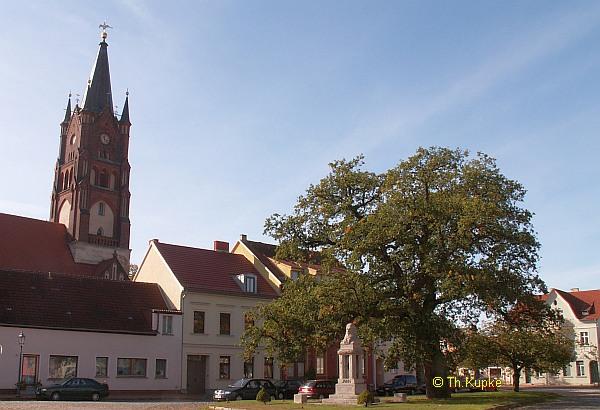German Town Asks Berlin to Pay Back 450-Year-Old Loan
Salzmarkt in Mittenwalde, Germany. (Photo: Th. Kupke)
Think 17th century hymns for Thursday’s Geo-Quiz.
Paul Gerhardt, one of Germany’s most prolific composers of hymns, is your first clue.
Back in the 17th century, Gerhardt lived for a short while in a city that’s the answer to our quiz.
Frankly, he’s the only semi-famous resident the city’s ever had.
A few more clues:
In the middle ages, this city was a major farming and trading center.
It was so wealthy that in the year 1562, Berlin, which is about 20 miles to the north-west, came begging for a loan.
The good burghers of our city agreed to lend Berlin the cash.
But it’s a debt that’s yet to be repaid.
The answer is Mittenwalde, Germany.
“Sleepy village” might be the best way to describe Mittenwalde today. It’s got about 9,000 inhabitants, some medieval ruins, and the fact that Paul Gerhardt once lived there. No, seriously. Gerhardt was HUGE back in the 17th century.
But Mittenwalde’s history is, well, rich. Literally.
“The city was founded in the 11th century,” says Uwe Pfeiffer, who has served as the town’s mayor since 1990.
“It had lots of agriculture, and our farmers were comparatively wealthy. At the same time,” Pfeiffer adds, “Mittenwalde was a trade center, and that gave us additional income.”
In fact, by 1562, Mittenwalde was so wealthy that nearby Berlin came begging for a loan. And Sonia Sobek, who works for Mittenwalde’s mayor, says her city didn’t hesitate.
“Berlin had in our city many debts. Exactly – 400 guilders with six percent interest.” In today’s terms, Mittenwalde’s loan to Berlin was worth more than $120 million.
“It was issued as a promissory note for that amount, but with no stamp on it,” Sobek tells me. “And that’s a problem, because Berlin pays no debts without a stamp on the debt certificate.”
And so for all of these years, Berlin has refused to pay up. Town historians in Mittenwalde have repeatedly said the promissory note, which has from time to time hung framed in the mayor’s office, is authentic.
Occasionally, a delegation from Mittenwalde will go to Berlin to plead the town’s case.
And for good reason – 450 years of interest adds up. Mittenwalde now reckons that Berlin’s debt is in the trillions.
Recently, Mayor Pfeiffer and others from Mittenwalde met with Berlin officials.
You’ll be shocked to hear that they didn’t drive home with trillions of dollars. After all, Berlin’s own city budget is more than $50 million in the red.
But the Mittenwalde delegation did NOT come home empty handed.
“The result of the meeting was that the town got one guilder from the state museum of Berlin. This one’s from 1539, the time of Joachim II of Brandenburg,” says Sonia Sobek.
So, one gold coin from the time the loan was made – that’s what Mittenwalde got for all its trouble.
Still, officials put that guilder in the city museum.
No doubt, the words of Berlin’s finance minister still ring in the town’s ears:
“This case shows that debts always catch up with you…no matter how old they are,” Ulrich Nussbaum told a Berlin newspaper.
Come to think of it, I’m pretty sure some other officials in Berlin have been saying that to the Greeks for a couple of years now.
